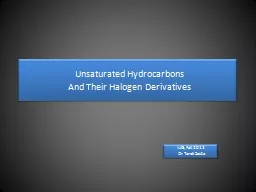

And Their Halogen Derivatives IUG Fall 2012 Dr Tarek Zaida Alkenes and Alkynes 1 Alkenes are compounds containing carbon carbon double bonds The simplest alkene ethene is a plant hormone ID: 302146
Download Presentation The PPT/PDF document "Unsaturated Hydrocarbons" is the property of its rightful owner. Permission is granted to download and print the materials on this web site for personal, non-commercial use only, and to display it on your personal computer provided you do not modify the materials and that you retain all copyright notices contained in the materials. By downloading content from our website, you accept the terms of this agreement.
Slide1
Unsaturated Hydrocarbons And Their Halogen Derivatives
IUG, Fall 2012
Dr
Tarek
ZaidaSlide2
Alkenes and Alkynes
1.
Alkenes
are compounds containing carbon –carbon double bonds
The simplest
alkene
,
ethene
, is a plant hormone.
Alkenes have physical properties similar to those of
alkanes
.
They are less dense than water and, being
nonpolar
, are not very soluble in water.
As with
alkanes
, compounds with four or fewer carbons are gases, whereas higher
homologs
are volatile liquids.Slide3
2. Alkynes,
compounds containing carbon–carbon triple bonds,
are similar to alkenes in their physical properties and chemical behavior.Slide4
General structural formula of Alkene and AlkynesSlide5
Both of these classes of hydrocarbons are unsaturated, because they contain fewer hydrogens
per carbon than
alkanes
(C
n
H
2n+2).
Alkanes
can be obtained from alkenes or alkynes by adding 1 or 2 moles of hydrogen.Slide6
What are all of the structural possibilities for the compound C3
H
4
?Slide7
Nomenclature
The IUPAC rules for naming alkenes and alkynes are similar to those for
alkanes
but a few rules must be added for naming and locating the multiple bonds.
1. The ending -
ene
is used to designate a carbon–carbon double bond. When more than one double bond is present, the ending is -
diene
, -
triene
, and so on. The ending -
yne
is used for a triple bond (-
diyne
for two triple bonds and so on). Compounds with a double and a triple bond are -
enynes
.
2. Select the longest chain that includes both carbons of the double or triple bond. Slide8
For example,Slide9
3. Number the chain from the end nearest the multiple bond so that the carbon atoms in that bond have the lowest possible numbers.
If the multiple bond is equidistant from both ends of the chain, number the chain from the
end nearest the first branch point
.Slide10
4. Indicate the position of the multiple bond using the lower numbered carbon atom of that bond. For example,
5. If more than one multiple bond is present, number the chain from the end nearest the first multiple bond.Slide11
If a double and a triple bond are equidistant from the end of the chain,
the double
bond receives the lowest numbers
. For example,Slide12Slide13
The root of the name (eth- or prop-) tells us the number of carbons, and the ending (-ane
, -
ene
, or -
yne
) tells us whether the bonds are single, double, or triple. No number is necessary in these cases, because in each instance, only one structure is possible.
With four carbons, a number is necessary to locate the double or triple bond.Slide14
Branches are named in the usual waySlide15
CycloalkenesSlide16Slide17
Reactions of Alkenes
1. Hydrogenation:
Slide18
Same with cycloalkenesSlide19
19
2. Addition
of Halogens to Alkenes
X
2
= Cl
2
and Br
2Slide20
Polymers
Large organic molecules formed from joining similar smaller molecules together.
The process is called polymerization.Slide21
Types of polymers
Naturally occurring:
Proteins,
Starch,
Cellulose
Rubber
Isoprene (present in natural rubber)
Slide22
2. Synthetic polymers:
Plastic
Nylon
Rayon (from cellulose)
Dacron (polyester)Slide23
Medical Uses of Polymers
Synthetic heart valves
Blood vessels
Surgical mesh
Disposable syringes
Drug containers Slide24Slide25Slide26Slide27
Because rotation at carbon–carbon double bonds is restricted, cis
–trans isomerism
(geometric isomerism) is possible in appropriately substituted alkenes.
For example, 1,2-dichloroethene exists in two different forms:
Cis
–Trans IsomerismSlide28Slide29
Cis-trans isomerism is possible for ring structure too:
Draw the structures of the cis-1,2-dimethylcyclopropane & trans-1,2-dimethylcyclopropaneSlide30
Cis-trans occurs in fatty acidsA biologically active cis
-trans isomer is
Cisplatin
, a chemotherapeutic agent used in the treatment of cancer.Slide31
Examples of biologically important Alkenes
Ethene
Linolenic
acid
Arachidonic
acid
β
-carotene
Vitamin A
Isoprene